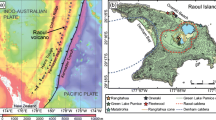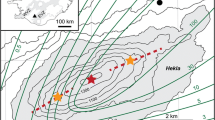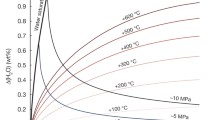Abstract
Plinian/ignimbrite activity stopped briefly and abruptly 16 and 45 h after commencement of the 1912 Novarupta eruption defining three episodes of explosive volcanism before finally giving way after 60 h to effusion of lava domes. We focus here on the processes leading to the termination of the second and third of these three episodes. Early erupted pumice from both episodes show a very similar range in bulk vesicularity, but the modal values markedly decrease and the vesicularity range widens toward the end of Episode III. Clasts erupted at the end of each episode represent textural extremes; at the end of Episode II, clasts have very thin glass walls and a predominance of large bubbles, whereas at the end of Episode III, clasts have thick interstices and more small bubbles. Quantitatively, all clasts have very similar vesicle size distributions which show a division in the bubble population at 30 μm vesicle diameter and cumulative number densities ranging from 107–109 cm–3. Patterns seen in histograms of volume fraction and the trends in the vesicle size data can be explained by coalescence signatures superimposed on an interval of prolonged nucleation and free growth of bubbles. Compared to experimental data for bubble growth in silicic melts, the high 1912 number densities suggest homogeneous nucleation was a significant if not dominant mechanism of bubble nucleation in the dacitic magma. The most distinct clast populations occurred toward the end of Plinian activity preceding effusive dome growth. Distributions skewed toward small sizes, thick walls, and teardrop vesicle shapes are indicative of bubble wall collapse marking maturation of the melt and onset of processes of outgassing. The data suggest that the superficially similar pauses in the 1912 eruption which marked the ends of episodes II and III had very different causes. Through Episode III, the trend in vesicle size data reflects a progressive shift in the degassing process from rapid magma ascent and coupled gas exsolution to slower ascent with partial open-system outgassing as a precursor to effusive dome growth. No such trend is visible in the Episode II clast assemblages; we suggest that external changes involving failure of the conduit/vent walls are more likely to have effected the break in explosive activity at 45 h.
















Similar content being viewed by others
References
Blower JD, Keating JP, Mader HM, Phillips JC (2001a) Inferring volcanic degassing processes from vesicle size distributions. Geophys Res Lett 28:347–350
Blower JD, Mader HM, Wilson SDR (2001b) Coupling of viscous and diffusive controls on bubble growth during explosive volcanic eruptions. Earth Planet Sci Lett 193:47–56
Blower JD, Keating JP, Mader HM, Phillips JC (2002) The evolution of bubble size distributions in volcanic eruptions. J Volcanol Geotherm Res 120:1–23
Bursik MI, Woods AW (1991) Buoyant, superbuoyant and collapsing eruption columns. J Volcanol Geotherm Res 45:347–350
Bursik MI, Carey SN, Sparks RSJ (1992) A gravity current model for the May 18, 1980 Mount St. Helens plume. Geophys Res Lett 19:1663–1666
Carey S, Sparks RSJ (1986) Quantitative models of the fallout and dispersal of tephra from volcanic eruption columns. Bull Volcanol 48:109–125
Carey S, Sigurdsson H (1989) The intensity of Plinian eruptions. Bull Volcanol 51:28–40
Carey S, Sigurdsson H, Gardner JE, Criswell W (1990) Variations in column height and magma discharge during the May 18, 1980 eruption of Mount St Helens. J Volcanol Geotherm Res 43:99–112
Cas RAF, Wright JV (1987) Volcanic successions: modern and ancient. Allen and Unwin, London, pp 1–528
Cashman KV (1992) Groundmass crystallization of Mount St Helens dacite, 1980–1986-a tool for interpreting shallow magmatic processes. Contrib Mineral Petrol 109:431–449
Cashman KV, Marsh BD (1988) Crystal size distribution (CSD) in rocks and the kinetics and dynamics of crystallization. II. Makaopuhi Lava Lake. Contrib Mineral Petrol 99:292–305
Cashman KV, Mangan MT (1994) Physical aspects of magmatic degassing. II. Constraints on vesiculation processes from textural studies of eruptive products. In: Carroll MR, Holloway JR (eds) Volatiles in Magmas. Rev Mineral 30:447–478
Cashman KV, Sturtevant B, Papale P, Navon O (2000) Magmatic fragmentation. In: Sigurdsson H (ed) Encyclopedia of volcanoes. Academic Press, San Diego, pp 421–430
Cioni R, Santacroce R, Sbrana A (1999) Pyroclastic deposits as a guide for reconstructing the multi-stage evolution of the Somma-Vesuvius Caldera. Bull Volcanol 61:207–222
Coombs ML, Gardner JE (2001) Shallow-storage conditions for the rhyolite of the 1912 eruption at Novarupta, Alaska. Geol Soc Am Bull 29:775–778
Curtis GH (1968) The stratigraphy of the ejecta of the 1912 eruption of Mount Katmai and Novarupta, Alaska. Geol Soc Am Bull 72:153–210
Dobran F (2001) Volcanic Processes: Mechanisms in Material Transport. Kluwer/Plenum, New York, pp 1–618
Druitt TH, Young SR, Baptie B, Bonadonna C, Calder ES, Clarke AB, Cole PD, Harford CL, Herd RA, Luckett R, Ryan G, Voight B (2002) Episodes of cyclic Vulcanian explosive activity with fountain collapse at Soufrière Hills Volcano, Montserrat. In: Druitt TH, Kokelaar BP (eds) The eruption of Soufrière Hills volcano, Montserrat, from 1995 to 1999. Geol Soc London Mem 21:281–306
Ernst GGJ, Sparks RSJ, Carey SN, Bursik MI (1996) Sedimentation from turbulent jets and plumes. J Geophys Res 101:5575–5589
Fierstein J, Hildreth W (1992) The plinian eruptions of 1912 at Novarupta, Katmai National Park, Alaska. Bull Volcanol 54:646–684
Francis P (1993) Volcanoes: a planetary perspective. Oxford University Press, New York, pp 1–443
Gaonac’h H, Lovejoy S, Stix J, Scherzter D (1996a) A scaling growth model for bubbles in basaltic lava flows. Earth Planet Sci Lett 139:395–409
Gaonac’h H, Stix J, Lovejoy S (1996b) Scaling effects on vesicle shape, size and heterogeneity of lavas from Mount Etna. J Volcanol Geotherm Res 74:131–153
Gardner JE, Thomas RME, Jaupart C, Tait S (1996) Fragmentation of magma during Plinian volcanic eruptions. Bull Volcanol 58:144–162
Gardner JE, Hilton M, Carroll MR (1999) Experimental constraints on degassing of magma: isothermal bubble growth during continuous decompression from high pressure. Earth Planet Sci Lett 168:201–218
Gurioli L, Houghton B, Cashman K, Cioni R (2004) Complex changes in eruption dynamics during the 79 AD eruption of Vesuvius. Bull Volcanol 67:144–159
Hammer JE, Cashman KV, Hoblitt RP, Newman S (1999) Degassing and microlite crystallization during pre-climactic events of the 1991 eruption of Mt. Pinatubo, Philippines. Bull Volcanol 60:355–380
Hammer JE, Rutherford MJ, Hildreth W (2002) Magma storage prior to the 1912 eruption at Novarupta, Alaska. Contrib Mineral Petrol 144:144–162
Hess KU, Dingwell DB (1996) Viscosities of hydrous leucogranitic melts: a non-Arrhenian model. Am Mineral 81:1297–1300
Hildreth W (1983) The compositionally zoned eruption of 1912 in the Valley of Ten Thousand Smokes, Katmai National Park, Alaska. J Volcanol Geotherm Res 18:1–56
Hildreth W (1987) New perspectives on the eruption of 1912 in the Valley of Ten Thousand Smokes, Katmai National Park, Alaska. Bull Volcanol 49:680–693
Hildreth W (1991) The timing of caldera collapse at Mount Katmai in response to magma withdrawal towards Novarupta. Geophys Res Lett 18:1541–1544
Hildreth W, Fierstein J (2000) Katmai volcanic cluster and the great eruption of 1912. Geol Soci Am Bull 112:1594–1620
Houghton BF, Wilson CJN (1989) A vesicularity index for pyroclastic deposits. Bull Volcanol 51:451–462
Houghton BF, Hobden BJ, Cashman KV, Wilson CJN, Smith RT (2003) Large-scale interaction of lake water and rhyolitic magma during the 1.8 ka Taupo eruption, New Zealand. In: White JDL, Smellie JL, Clague DA (eds) Explosive subaqueous volcanism. Geophys Monograph 140:97–109
Houghton BF, Wilson CJN, Fierstein J, Hildreth W (2004) Complex proximal deposition during the Plinian eruptions of 1912 at Novarupta, Alaska. Bull Volcanol 66:95–133
Hurwitz S, Navon O (1994) Bubble nucleation in rhyolite melts: experiments at high pressure, temperature, and water content. Earth Planet Sci Lett 122:267–280
Jaupart C, Allegre CJ (1991) Gas content, eruption rate and instabilities of eruption regime in silicic volcanoes. Earth Planet Sci Lett 102:413–429
Jaupart C, Tait S (1994) Dynamics of eruptive phenomena. In: Carroll MR, Holloway JR (eds) Volatiles in magmas. Rev Mineral 30:213–238
Klug C, Cashman KV (1994) Vesiculation of May 18, 1980, Mount St. Helens magma. Geology 22:468–472
Klug C, Cashman KV (1996) Permeability development in vesiculating magmas: implications for fragmentation. Bull Volcanol 58:87–100
Klug C, Cashman KV, Bacon CR (2002) Structure and physical characteristics of pumice from the climactic eruption of Mount Mazama (Crater Lake), Oregon. Bull Volcanol 64:486–501
Kokelaar BP (2002) Setting, chronology and consequences of the eruption of Soufrière Hills Volcano, Montserrat (1995–1999). In: Druitt TH, Kokelaar BP (eds) The eruption of Soufrière Hills volcano, Montserrat, from 1995 to 1999. Geol Soc London Mem 21:1–43
Koyaguchi T (1994) Grain-sized variation of tephra derived from volcanic umbrella clouds. Bull Volcanol 56:1–9
Lowenstern JB (1993) Evidence for a copper-bearing fluid in magma erupted at the Valley of Ten Thousand Smokes, Alaska. Contrib Mineral Petrol 114:409–421
Lyakhovsky V, Hurwitz S, Navon O (1996) Bubble growth in rhyolitic melts: experimental and numerical investigation. Bull Volcanol 58:19–32
Manga M, Castro J, Cashman KV, Loewenberg M (1998) Rheology of bubble-bearing magmas. J Volcanol Geotherm Res 87:15–28
Mangan MT, Cashman KV (1996) The structure of basaltic scoria and reticulite and inferences for vesiculation, foam formation, and fragmentation in lava fountains. J Volcanol Geotherm Res 73:1–18
Mangan MT, Sisson T (2000) Delayed, disequilibrium degassing in rhyolite magma: decompression experiments and implications for explosive volcanism. Earth Planet Sci Lett 183:441–455
Mangan MT, Cashman KV, Newman S (1993) Vesiculation of basaltic magma during eruption. Geology 21:157–160
Mangan MT, Mastin L, Sisson T (2004) Gas evolution in eruptive conduits: combining insights from high temperature and pressure decompression experiments with steady-state flow modeling. J Volcanol Geotherm Res 129:23–36
Marsh BD (1988) Crystal size distribution (CSD) in rocks and the kinetics and dynamics of crystallization. I. Theory. Contrib Mineral Petrol 99:277–291
Marti J, Soriano C, Dingwell DB (1999) Tube pumices as strain markers of the ductile-brittle transition during magma fragmentation. Nature 402:650–653
Melnik O (2000) Dynamics of two-phase conduit flow of high-viscosity gas-saturated magma: large variations of sustained explosive eruption intensity. Bull Volcanol 62:153–170
Mourtada-Bonnefoi CC, Laporte D (1999) Experimental study of homogenous bubble nucleation in rhyolitic magmas. Geophys Res Lett 26:3505–3508
Navon O, Lyakhovsky V (1998) Vesiculation processes in silicic magmas. In: Gilbert GS, Sparks RSJ (eds) Geol Soc Spec Publ 145:27–50
Orsi G, Gallo G, Heiken G, Wohletz K, Yu E, Bonani G (1992) A comprehensive study of pumice formation and dispersal: the Cretaio tephra of Ischia (Italy). J Volcanol Geotherm Res 53:329–354
Paladio-Melosantos ML, Solidum R, Scott WE, Quimbao RB, Umbal JV, Rodolfo KS, Tubianosa BS, Delos Reyes PJ (1995) Tephra falls of the 1991 eruptions of Mount Pinatubo. In: Newhall CGP, Punongbayan RS (eds) Fire and mud: eruptions and lahars of Mount Pinatubo. Washington Press, Philippines, pp 513–535
Pinkerton H, Stevenson RJ (1992) Methods of determining the rheological properties of magmas at sub-liquidus temperatures. J Volcanol Geotherm Res 53:47–66
Polacci M, Papale P, Rosi M (2001) Textural heterogeneities in pumices from the climactic eruptions of Mount Pinatubo, 15 June 1991, and implications for magma ascent dynamics. Bull Volcanol 63:83–97
Polacci M, Pioli L, Rosi M (2003) The Plinian phase of the Campanian Ignimbrite eruption (Phlegrean Fields, Italy): evidence from density measurements and textural characterization of pumice. Bull Volcanol 65:418–432
Proussevitch AA, Sahagian DL (1996) Dynamics of coupled diffusive and decompressive bubble growth in magmatic systems. J Geophys Res 101:17447–17455
Proussevitch AA, Sahagian DL (1998) Dynamics and energetics of bubble growth in magmas: analytical formulation and numerical modeling. J Geophys Res 103:18223–18251
Proussevitch AA, Sahagian DL, Kutolin VA (1993) Stability of foams in silicate melts. J Volcanol Geotherm Res 59:161–178
Pyle DM (1989) The thickness, volume and grain-size of tephra fall deposits. Bull Volcanol 51:1–15
Rosi M, Paladio-Melosantos ML, Dimuro A, Leoni R, Bacolcol T (2001) Fall vs flow activity during the 1991 climactic eruption of Pinatubo Volcano (Philippines). Bull Volcanol 62:549–566
Rust AC, Manga M, Cashman KV (2003) Determining flow type, shear rate and shear stress in magmas from bubble shapes and orientations. J Volcanol Geotherm Res 122:111–132
Sahagian DL, Proussevitch AA (1998) 3D particle size distributions from 2D observations: stereology for natural applications. J Volcanol Geotherm Res 84:173–196
Self S (1992) Krakatau revisited: the course of events and interpretation of the 1883 eruption. GeoJournal 28:109–121
Self S, Rampino MR (1981) The 1883 eruption of Krakatau. Nature 294:699–704
Sigurdsson H, Carey SN, Espindola JM (1984) The 1982 eruptions of El Chichon volcano, Mexico: stratigraphy of pyroclastic deposits. J Volcanol Geotherm Res 23:11–37
Simakin A, Armienti P, Epel’baum M (1999) Coupled degassing and crystallization: experimental study at continuous pressure drop with application to volcanic bombs. Bull Volcanol 61:275–287
Sparks RSJ (1986) The dimensions and dynamics of volcanic eruption columns. Bull Volcanol 48:3–15
Sparks RSJ, Brazier S (1982) New evidence for degassing processes during explosive eruptions. Nature 295:218–220
Sparks RSJ, Bursik MI, Ablay GJ, Thomas RME, Carey SN (1992) Sedimentation of tephra by volcanic plumes. II. Controls on thickness and grain-size variations of tephra fall deposits. Bull Volcanol 54:685–695
Sparks RSJ, Bursik MI, Carey SN, Gilbert JS, Glaze LS, Sigurdsson H, Woods AW (1997) Volcanic plumes. Wiley, Chichester, pp 1–574
Spera FJ (2000) Physical properties of magma. In: Sigurdsson H (ed) Encyclopedia of Volcanoes. Academic Press, San Diego pp 171–190
Thomas N, Jaupart C, Vergniolle S (1994) On the vesicularity of pumice. J Geophys Res 99:15,633–15,644
Toramaru A (1988) Formation of propagation pattern in two-phase flow systems with application to volcanic eruptions. Geophys J 95:613–623
Toramaru A (1989) Vesiculation process and bubble size distributions in ascending magmas with constant velocities. J Geophys Res 94:17523–17542
Toramaru A (1990) Measurement of bubble size distributions in vesiculated rocks with implications for quantitative estimation of eruptive processes. J Volcanol Geotherm Res 43:71–90
Walker GPL (1973) Explosive volcanic eruptions: a new classification scheme. Geol Rundsch 62:431–446
Whitham A, Sparks R (1986) Pumice. Bull Volcanol 48:209–223
Wilson CJN, Walker GPL (1985) The Taupo eruption, New Zealand. I. General aspects. Philos Trans R Soc Lond A314:199–228
Wilson L, Sparks RSJ, Walker GPL (1980) Explosive volcanic eruptions-IV. The control of magma properties and conduit geometry on eruption column behaviour. Geophys J R Astr Soc 63:117–148
Wilson L, Walker GPL (1987) Explosive volcanic eruptions-VI. Ejecta dispersal in plinian eruptions: the control of eruption conditions and atmospheric properties. Geophys J R Astr Soc 89:657–679
Woods AW (1988) The fluid-dynamics and thermodynamics of eruption columns. Bull Volcanol 50:169–193
Woods AW, Bower SM (1995) The decompression of volcanic jets in a crater during explosive volcanic eruptions. Earth Planet Sci Lett 131:189–205
Acknowledgements
The authors thank Judy Fierstein and Maggie Mangan for their constructive comments about the eruption at Novarupta and the degassing of silicic magmas. Colin Wilson played a major role in the fieldwork that established a stratigraphic framework for this project. Our work was supported by NSF grant EAR-01-06700. Images were collected on the SEM belonging to HIGP (Hawaii Institute of Geophysics and Planetology).
Author information
Authors and Affiliations
Corresponding author
Additional information
Editorial responsibility: J. Stix
Rights and permissions
About this article
Cite this article
Adams, N.K., Houghton, B.F. & Hildreth, W. Abrupt transitions during sustained explosive eruptions: examples from the 1912 eruption of Novarupta, Alaska. Bull Volcanol 69, 189–206 (2006). https://doi.org/10.1007/s00445-006-0067-4
Received:
Accepted:
Published:
Issue Date:
DOI: https://doi.org/10.1007/s00445-006-0067-4




